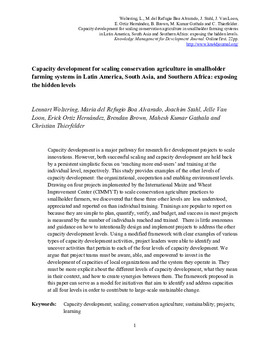Mostrar el registro sencillo del ítem
Capacity development for scaling conservation agriculture in smallholder farming systems in Latin America, South Asia, and Southern Africa: exposing the hidden levels
| Creador: | Woltering, L. |
| Creador: | Boa, M. |
| Creador: | Stahl, J. |
| Creador: | Van Loon, J. |
| Creador: | Ortiz Hernández, E. |
| Creador: | Brown, B. |
| Creador: | Gathala, M.K. |
| Creador: | Thierfelder, C. |
| Año: | 2022 |
| URI: | https://hdl.handle.net/10883/22245 |
| Lenguaje: | English |
| Editor: | KM4Dev |
| Copyright: | CIMMYT manages Intellectual Assets as International Public Goods. The user is free to download, print, store and share this work. In case you want to translate or create any other derivative work and share or distribute such translation/derivative work, please contact CIMMYT-Knowledge-Center@cgiar.org indicating the work you want to use and the kind of use you intend; CIMMYT will contact you with the suitable license for that purpose |
| Tipo: | Article |
| País de enfoque: | Latin America |
| País de enfoque: | South Asia |
| País de enfoque: | Southern Africa |
| Lugar de publicación: | [Place of publication not identified] |
| Volumen: | In press |
| Descripción: | Capacity development is a major pathway for research for development projects to scale innovations. However, both successful scaling and capacity development are held back by a persistent simplistic focus on ‘reaching more end-users’ and training at the individual level, respectively. This study provides examples of the other levels of capacity development: the organizational, cooperation and enabling environment levels. Drawing on four projects implemented by the International Maize and Wheat Improvement Center (CIMMYT) to scale conservation agriculture practices to smallholder farmers, we discovered that these three other levels are less understood, appreciated and reported on than individual training. Trainings are popular to report on because they are simple to plan, quantify, verify, and budget, and success in most projects is measured by the number of individuals reached and trained. There is little awareness and guidance on how to intentionally design and implement projects to address the other capacity development levels. Using a modified framework with clear examples of various types of capacity development activities, project leaders were able to identify and uncover activities that pertain to each of the four levels of capacity development. We argue that project teams must be aware, able, and empowered to invest in the development of capacities of local organizations and the system they operate in. They must be more explicit about the different levels of capacity development, what they mean in their context, and how to create synergies between them. The framework proposed in this paper can serve as a model for initiatives that aim to identify and address capacities at all four levels in order to contribute to large-scale sustainable change. |
| Agrovoc: | CAPACITY DEVELOPMENT |
| Agrovoc: | FARMING SYSTEMS |
| Agrovoc: | SCALING UP |
| Agrovoc: | CONSERVATION AGRICULTURE |
| Agrovoc: | SUSTAINABILITY |
| Agrovoc: | PROJECTS |
| Agrovoc: | LEARNING |
| ISSN: | 1871-6342 |
| Revista: | Knowledge Management for Development Journal |
| Área de impacto CGIAR: | Nutrition, health & food security |
| Área de impacto CGIAR: | Climate adaptation & mitigation |
| Área de impacto CGIAR: | Environmental health & biodiversity |
| Área de impacto CGIAR: | Gender equality, youth & social inclusion |
| Iniciativa CGIAR: | Transforming Agrifood Systems in South Asia |
| Iniciativa CGIAR: | Diversification in East and Southern Africa |
| Área de acción CGIAR: | Resilient Agrifood Systems |
| Donante o financiador: | Federal Ministry for Economic Cooperation and Development (BMZ) |
| Donante o financiador: | CGIAR Trust Fund |
| Donante o financiador: | United States Agency for International Development (USAID) |
| Identificador CGSpace: | https://hdl.handle.net/10568/125133 |
Ficheros en el ítem
Este ítem aparece en la(s) siguiente(s) colección(ones)
-
Sustainable Agrifood Systems
Buffer collection to upload SIP Latam information products. -
Sustainable Intensification
Sustainable intensification agriculture including topics on cropping systems, agronomy, soil, mechanization, precision agriculture, etc.

